【中考复习方案】2015届九年级英语复习课件(人教):第3课时 Units1—4 Book 7B
文档属性
| 名称 | 【中考复习方案】2015届九年级英语复习课件(人教):第3课时 Units1—4 Book 7B | 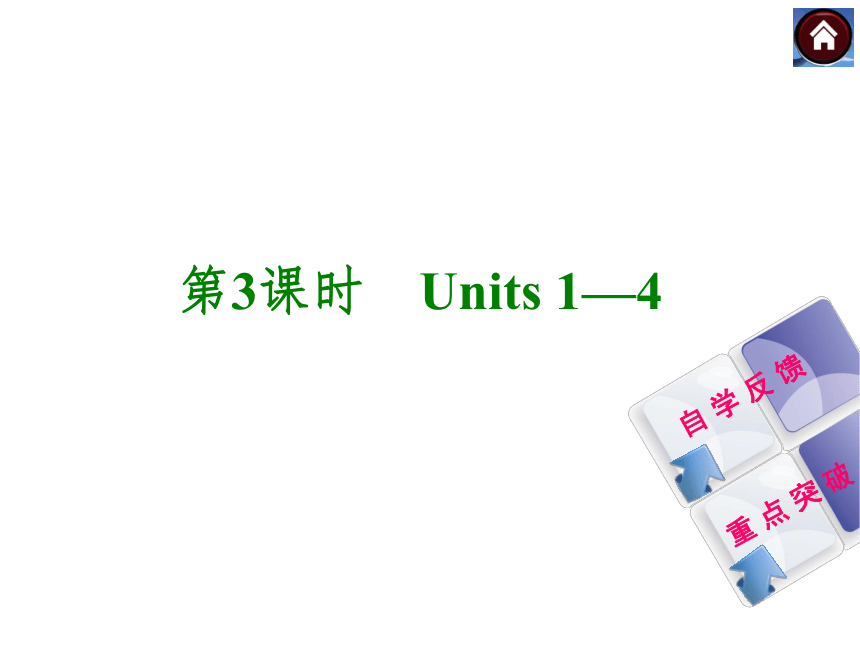 | |
| 格式 | zip | ||
| 文件大小 | 955.2KB | ||
| 资源类型 | 教案 | ||
| 版本资源 | 人教新目标(Go for it)版 | ||
| 科目 | 英语 | ||
| 更新时间 | 2014-12-04 21:57:40 | ||
图片预览


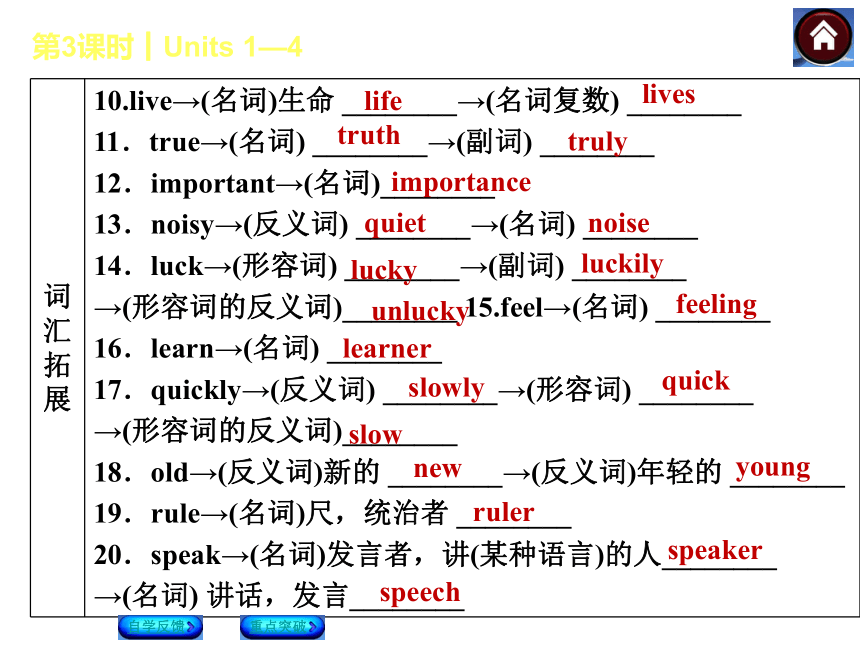
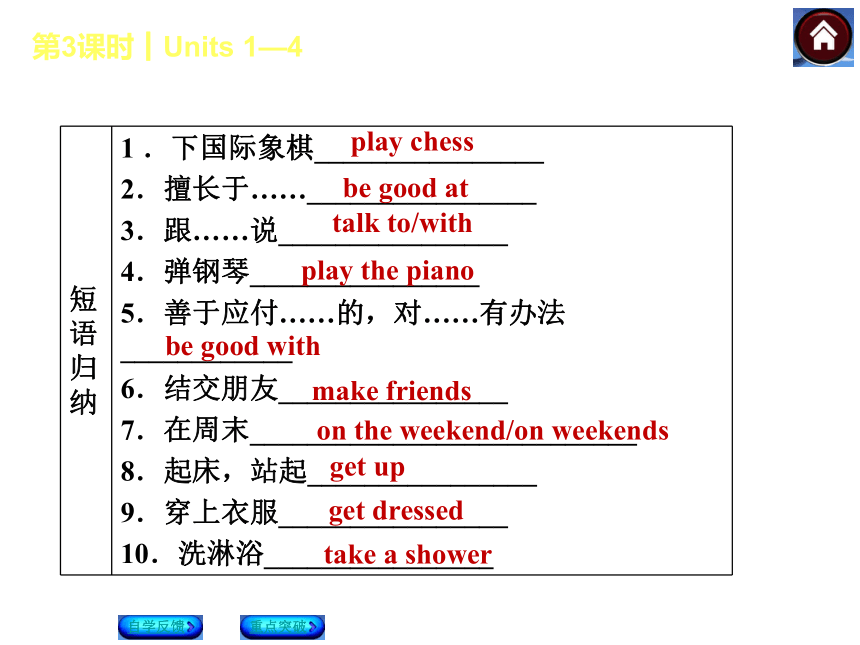
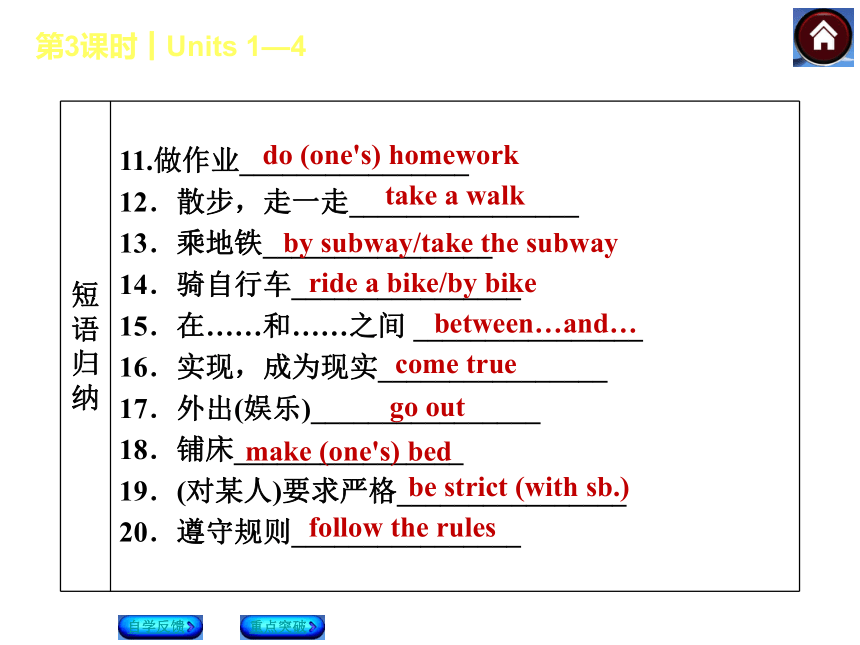
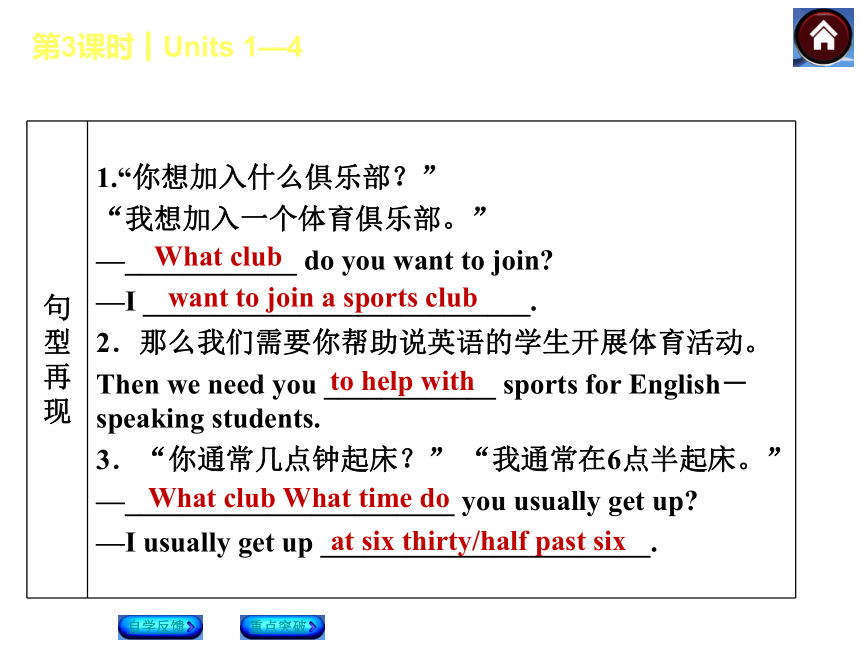
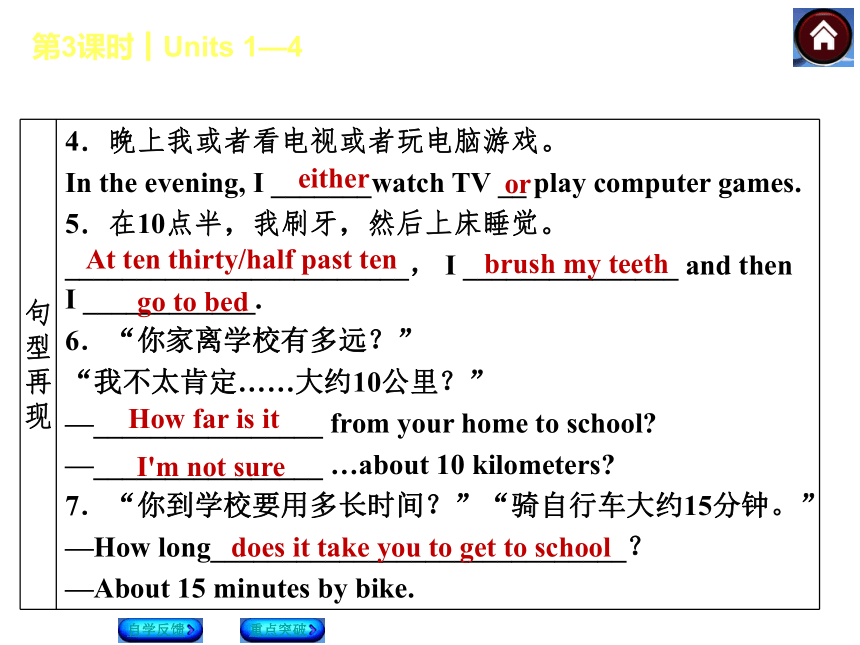
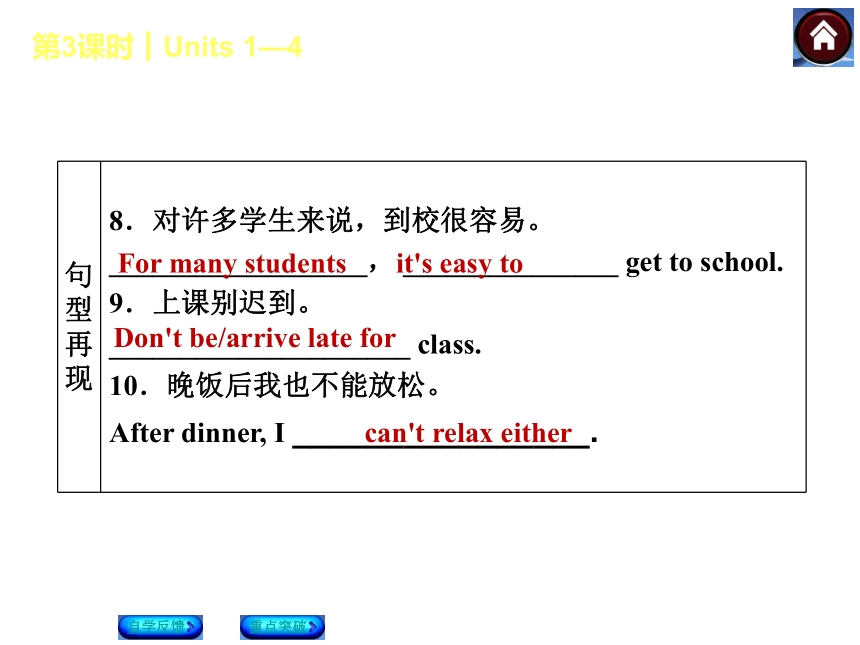
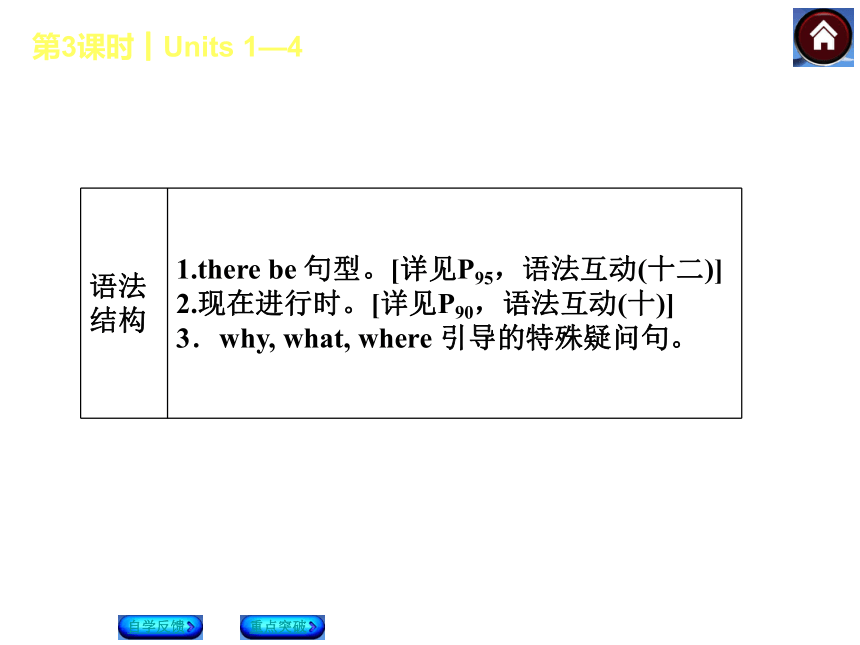
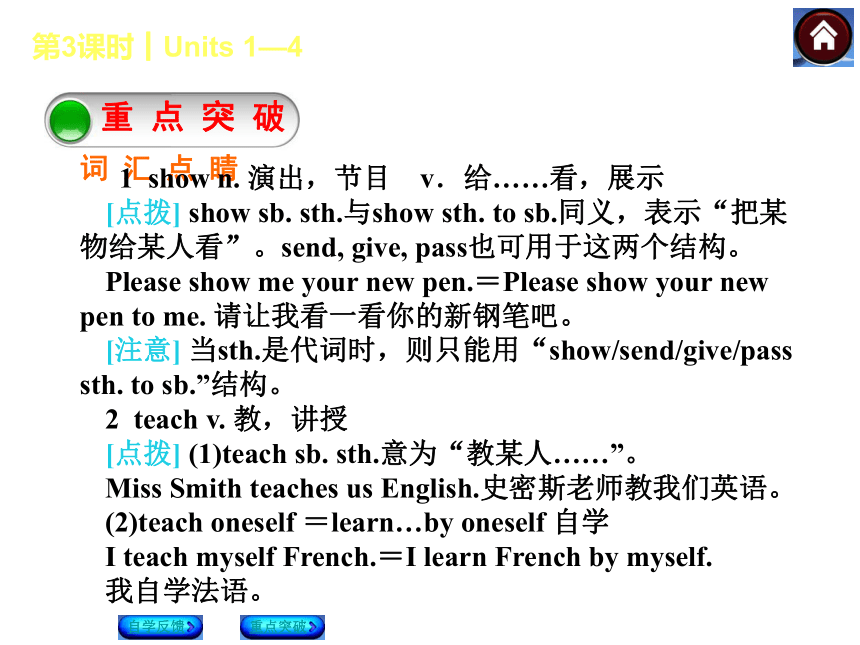
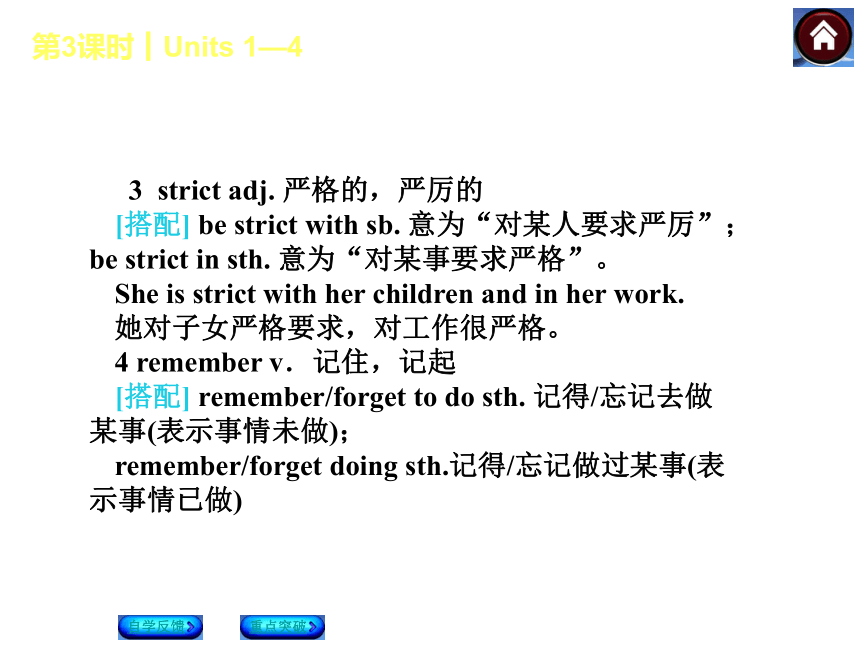
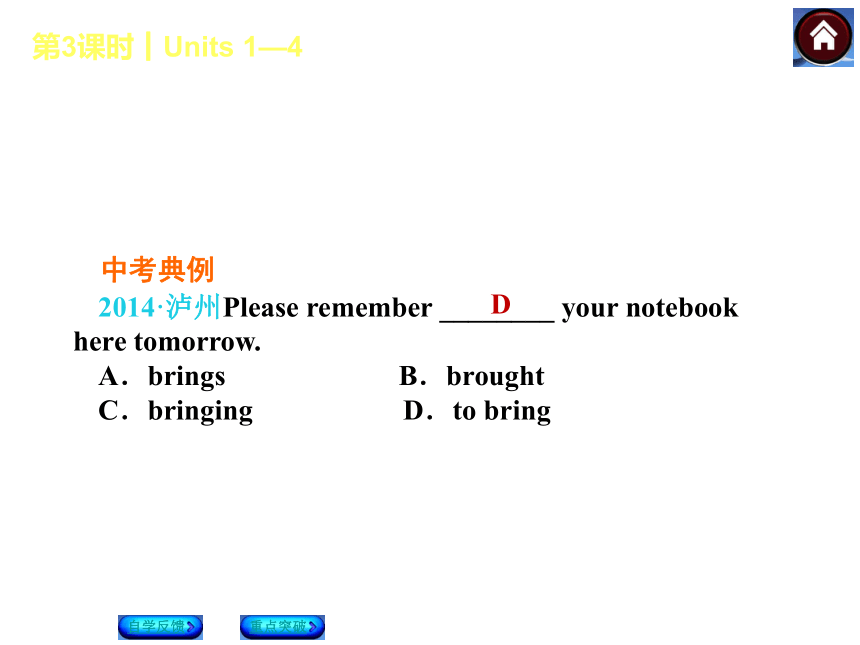
文档简介
课件30张PPT。自 学 反 馈重 点 突 破第3课时 Units 1—4 第3课时┃Units 1—4自学反馈重点突破自 学 反 馈singer central teeth usual unusual late earlierearliest halves dirty writer driver 第3课时┃Units 1—4life lives truthtrulyquiet importance noiselucky luckily自学反馈重点突破unluckyfeelinglearnerslowlyquickslownewyoungruler speakerspeech第3课时┃Units 1—4play chess自学反馈重点突破be good attalk to/withplay the pianobe good withmake friendson the weekend/on weekends get upget dressedtake a showerdo (one's) homeworktake a walk自学反馈重点突破第3课时┃Units 1—4by subway/take the subwayride a bike/by bikebetween…and…come truego outmake (one's) bedbe strict (with sb.) follow the rules第3课时┃Units 1—4What club自学反馈重点突破want to join a sports clubto help withWhat club What time doat six thirty/half past six第3课时┃Units 1—4either or自学反馈重点突破At ten thirty/half past ten brush my teethgo to bedHow far is itI'm not suredoes it take you to get to school第3课时┃Units 1—4 For many studentsit's easy toDon't be/arrive late forcan't relax either自学反馈重点突破第3课时┃Units 1—4自学反馈重点突破第3课时┃Units 1—4词 汇 点 睛 1 show n. 演出,节目 v.给……看,展示
[点拨] show sb. sth.与show sth. to sb.同义,表示“把某物给某人看”。send, give, pass也可用于这两个结构。
Please show me your new pen.=Please show your new pen to me. 请让我看一看你的新钢笔吧。
[注意] 当sth.是代词时,则只能用“show/send/give/pass sth. to sb.”结构。
2 teach v. 教,讲授
[点拨] (1)teach sb. sth.意为“教某人……”。
Miss Smith teaches us English.史密斯老师教我们英语。
(2)teach oneself =learn…by oneself 自学
I teach myself French.=I learn French by myself.
我自学法语。重 点 突 破自学反馈重点突破第3课时┃Units 1—4自学反馈重点突破 3 strict adj. 严格的,严厉的
[搭配] be strict with sb. 意为“对某人要求严厉”; be strict in sth. 意为“对某事要求严格”。
She is strict with her children and in her work.
她对子女严格要求,对工作很严格。
4 remember v.记住,记起
[搭配] remember/forget to do sth. 记得/忘记去做某事(表示事情未做);
remember/forget doing sth.记得/忘记做过某事(表示事情已做)第3课时┃Units 1—4自学反馈重点突破中考典例2014·泸州Please remember ________ your notebook here tomorrow.
A.brings B.brought
C.bringing D.to bringD第3课时┃Units 1—4巧 辩 异 同自学反馈重点突破 1 join/join in/take part in
(1)join表示加入某一党派或社会团体、组织,成为其中的一员。
He joined the Party last year.
去年他入了党。
(2)join in 意为“加入;参加(某种活动)”,表示“加入某人的某种活动”时,可用join sb. in (doing) sth.。
Will you join us in playing basketball?
你愿意和我们一起打篮球吗?
(3)take part in指参加会议或群众性活动,重在强调句子的主语参加该项活动并在其中发挥作用。
I'm going to take part in the sports meeting.
我将参加运动会。第3课时┃Units 1—4中考典例2013·天津He________ an English club last year and has improved his English a lot.
A.protected B.produced
C.Joined D.receivedC自学反馈重点突破第3课时┃Units 1—42 be good for/be good at/be good to/be goodwith
(1)be good for 表示“对……有好(益)处”,反义词组为be bad for。
Eating too much is not good for your health.
吃太多对你的健康没有好处。
(2)be good at与do well in同义,表示“在……方面(学得,做得)好,擅长……”,后接名词或动名词形式。
Some of us are good at swimming.
我们中有些人擅长游泳。
(3)be good to表示“对……仁慈(和善)”,与be kind/friendly to同义。
The old man is very good to the students.
那位老人对学生们很和善。
(4)be good with与get on well with同义, 表示“与……相处融洽”。
Mr. Smith is good with his neighbors.
史密斯先生和他的邻居们相处得很融洽。自学反馈重点突破第3课时┃Units 1—4中考典例2014·北京少开车对环境有好处。
To drive less is ________ the environment.good for自学反馈重点突破第3课时┃Units 1—43 across/through/over/past/cross
(1)across为介词,表示“从……表面穿过”或者“横穿”,across from意为“在……对面”。
He can swim across the river.他能游过这条河。
(2)through为介词,表示“从……内部穿过”,往往指穿过沙漠、森林,(光线)透过窗户等。
The river runs through the city.
这条河流经这座城市。
(3)over为介词,意为“翻越”,表示到达高的障碍物(如树、墙、篱笆和山脉等)的另一侧。
He jumped over the wall. 他跳过了墙。自学反馈重点突破第3课时┃Units 1—4(4)past为介词,意为“走过,经过”,指从某物或某人旁边经过。常用短语为“walk/go past=pass”。
He walked past me without saying “Hello”.
他没打招呼就从我身边走过去了。
(5)cross为动词,表示“穿过”,相当于go across。
The old man is crossing(=is going across)the road. 这位老人正在过马路。自学反馈重点突破第3课时┃Units 1—4自学反馈重点突破中考典例2013·内江The old man is a good swimmer, and even now he often swims ________ Tuojiang River after supper.
A.over B.through C.to D.acrossD第3课时┃Units 1—4 4 between/among
(1)between一般指在两者之间,常与and连用。
(2)among一般用于三者或三者以上的人或物之间。自学反馈重点突破中考典例2013·东营—Did you go to Kenli during the Peach Blossom Festival (桃花节)?
—Yes. The flowers were beautiful. Bees were flying ________ them.
A.in B.among C.between D.throughB“在花丛中”用介词among。解析 第3课时┃Units 1—4自学反馈重点突破5 wear/put on/dress/in2013·鞍山She hurriedly________ the child and took him downstairs.
A.put on B.Wore C.dressed D.had ondress 表示动作,dress sb. 意为“给某人穿衣服”。 解析 C第3课时┃Units 1—4自学反馈重点突破6 bring/take/get/carry2014·襄阳—I'm sorry I left my homework at home. Shall I go and ________ it?
—No, you needn't. Bring it here tomorrow.
A.get B.send C.take D.pass根据“I'm sorry I left my homework at home.”可知说话者要去拿,故选A。 解析 Abring意为“拿来;带来”,指从别处带到说话处。
take意为“拿去;带去”,指把某物(人)从说话处带到别处,
与bring所表示的方向相反。
get表示到某地去把某物取来,相当于fetch。
carry意为“搬运;携带”,没有方向性。第3课时┃Units 1—4自学反馈重点突破7 arrive/get/reach [注意]
(1)三者在一定情况下可相互转换。
(2)当它们后接地点副词there, here和home时,副词前不加任何介词。
When did you arrive/get/reach home?
你何时到家的?第3课时┃Units 1—4自学反馈重点突破 中考典例
2014 ·福州当那几个德国人到达机场时,雨正下得很大。
It was ________ heavily when the Germans ________ at the airport. rainingarrived第3课时┃Units 1—4句 型 透 视自学反馈重点突破 1 Then we need you to help with sports for English-speaking students. 那么我们需要你帮助说英语的学生开展体育活动。
[点拨] help with sth.帮助做某事;
help sb. (to) do sth.=help sb. with sth.
帮助某人做某事
[拓展] help oneself to sth.随便吃(喝)……;
with the help of sb.=with sb.'s help;
在某人的帮助下;
ask sb. for help 向某人求助第3课时┃Units 1—4 2 —How does Mary get to school?玛丽是如何到校?
—She takes the subway. 她坐地铁。
[点拨] 表示“乘坐某种交通工具”可用以下表达:
(1) take/ride/drive+冠词/形容词性物主代词+交通工具名词
(2) by+单数交通工具名词
(3)in/on+冠词/形容词性物主代词+交通工具名词
Dale rides a/his bike to work.
=Dale goes to work by bike.
=Dale goes to work on his bike.
戴尔骑自行车上班。
[拓展] “walk to+地点名词”与“go to+地点名词+on foot”同义,意为“步行去某地”。
Katrina often goes to school on foot.
=Katrina often walks to school.
卡特里娜经常步行去学校。自学反馈重点突破第3课时┃Units 1—4自学反馈重点突破典型例题
—Does your father go to work ________ car or ________ foot?
—Neither. He often goes to work by bus.
A.by; on B.by; by
C.on; by D.on; onA第3课时┃Units 1—43 How long does it take you to get to school? 你到学校要用多长时间?
[句型] “It takes (+sb.)+时间段+to do sth.”意为“花费(某人)多长时间做某事”,还可用“sb. spends+时间段+(in) doing sth.”表示。
It took Jim two hours to read the book.
=Jim spent two hours (in) reading the book.
吉姆花了两个小时读那本书。自学反馈重点突破第3课时┃Units 1—4自学反馈重点突破 中考典例
2014 ·白银It only ________ me half an hour________ to school every day last term.
A.takes; riding B.spent; to ride
C.cost; walk D.took; to walk D第3课时┃Units 1—4 4 For many students, it is easy to get to school. 对许多学生来说,到校很容易。
[句型] “It's+adj.+(for/of sb.)+to do sth.” 意为“做某事(对某人而言)是……的”,it是形式主语,后面的动词不定式为真正的主语。
[拓展] 该句型中,若形容词(如easy,important,necessary等)是对动作进行评价,则其后用介词for;若该形容词(如kind,friendly等)是用来描述人的性格或品质,则其后用介词of。
It was generous of you to contribute so much money.
你很大方,捐出这么多钱。
It's difficult for us to climb up the tree.
对我们来说,爬上那棵树是很困难的。自学反馈重点突破
[点拨] show sb. sth.与show sth. to sb.同义,表示“把某物给某人看”。send, give, pass也可用于这两个结构。
Please show me your new pen.=Please show your new pen to me. 请让我看一看你的新钢笔吧。
[注意] 当sth.是代词时,则只能用“show/send/give/pass sth. to sb.”结构。
2 teach v. 教,讲授
[点拨] (1)teach sb. sth.意为“教某人……”。
Miss Smith teaches us English.史密斯老师教我们英语。
(2)teach oneself =learn…by oneself 自学
I teach myself French.=I learn French by myself.
我自学法语。重 点 突 破自学反馈重点突破第3课时┃Units 1—4自学反馈重点突破 3 strict adj. 严格的,严厉的
[搭配] be strict with sb. 意为“对某人要求严厉”; be strict in sth. 意为“对某事要求严格”。
She is strict with her children and in her work.
她对子女严格要求,对工作很严格。
4 remember v.记住,记起
[搭配] remember/forget to do sth. 记得/忘记去做某事(表示事情未做);
remember/forget doing sth.记得/忘记做过某事(表示事情已做)第3课时┃Units 1—4自学反馈重点突破中考典例2014·泸州Please remember ________ your notebook here tomorrow.
A.brings B.brought
C.bringing D.to bringD第3课时┃Units 1—4巧 辩 异 同自学反馈重点突破 1 join/join in/take part in
(1)join表示加入某一党派或社会团体、组织,成为其中的一员。
He joined the Party last year.
去年他入了党。
(2)join in 意为“加入;参加(某种活动)”,表示“加入某人的某种活动”时,可用join sb. in (doing) sth.。
Will you join us in playing basketball?
你愿意和我们一起打篮球吗?
(3)take part in指参加会议或群众性活动,重在强调句子的主语参加该项活动并在其中发挥作用。
I'm going to take part in the sports meeting.
我将参加运动会。第3课时┃Units 1—4中考典例2013·天津He________ an English club last year and has improved his English a lot.
A.protected B.produced
C.Joined D.receivedC自学反馈重点突破第3课时┃Units 1—42 be good for/be good at/be good to/be goodwith
(1)be good for 表示“对……有好(益)处”,反义词组为be bad for。
Eating too much is not good for your health.
吃太多对你的健康没有好处。
(2)be good at与do well in同义,表示“在……方面(学得,做得)好,擅长……”,后接名词或动名词形式。
Some of us are good at swimming.
我们中有些人擅长游泳。
(3)be good to表示“对……仁慈(和善)”,与be kind/friendly to同义。
The old man is very good to the students.
那位老人对学生们很和善。
(4)be good with与get on well with同义, 表示“与……相处融洽”。
Mr. Smith is good with his neighbors.
史密斯先生和他的邻居们相处得很融洽。自学反馈重点突破第3课时┃Units 1—4中考典例2014·北京少开车对环境有好处。
To drive less is ________ the environment.good for自学反馈重点突破第3课时┃Units 1—43 across/through/over/past/cross
(1)across为介词,表示“从……表面穿过”或者“横穿”,across from意为“在……对面”。
He can swim across the river.他能游过这条河。
(2)through为介词,表示“从……内部穿过”,往往指穿过沙漠、森林,(光线)透过窗户等。
The river runs through the city.
这条河流经这座城市。
(3)over为介词,意为“翻越”,表示到达高的障碍物(如树、墙、篱笆和山脉等)的另一侧。
He jumped over the wall. 他跳过了墙。自学反馈重点突破第3课时┃Units 1—4(4)past为介词,意为“走过,经过”,指从某物或某人旁边经过。常用短语为“walk/go past=pass”。
He walked past me without saying “Hello”.
他没打招呼就从我身边走过去了。
(5)cross为动词,表示“穿过”,相当于go across。
The old man is crossing(=is going across)the road. 这位老人正在过马路。自学反馈重点突破第3课时┃Units 1—4自学反馈重点突破中考典例2013·内江The old man is a good swimmer, and even now he often swims ________ Tuojiang River after supper.
A.over B.through C.to D.acrossD第3课时┃Units 1—4 4 between/among
(1)between一般指在两者之间,常与and连用。
(2)among一般用于三者或三者以上的人或物之间。自学反馈重点突破中考典例2013·东营—Did you go to Kenli during the Peach Blossom Festival (桃花节)?
—Yes. The flowers were beautiful. Bees were flying ________ them.
A.in B.among C.between D.throughB“在花丛中”用介词among。解析 第3课时┃Units 1—4自学反馈重点突破5 wear/put on/dress/in2013·鞍山She hurriedly________ the child and took him downstairs.
A.put on B.Wore C.dressed D.had ondress 表示动作,dress sb. 意为“给某人穿衣服”。 解析 C第3课时┃Units 1—4自学反馈重点突破6 bring/take/get/carry2014·襄阳—I'm sorry I left my homework at home. Shall I go and ________ it?
—No, you needn't. Bring it here tomorrow.
A.get B.send C.take D.pass根据“I'm sorry I left my homework at home.”可知说话者要去拿,故选A。 解析 Abring意为“拿来;带来”,指从别处带到说话处。
take意为“拿去;带去”,指把某物(人)从说话处带到别处,
与bring所表示的方向相反。
get表示到某地去把某物取来,相当于fetch。
carry意为“搬运;携带”,没有方向性。第3课时┃Units 1—4自学反馈重点突破7 arrive/get/reach [注意]
(1)三者在一定情况下可相互转换。
(2)当它们后接地点副词there, here和home时,副词前不加任何介词。
When did you arrive/get/reach home?
你何时到家的?第3课时┃Units 1—4自学反馈重点突破 中考典例
2014 ·福州当那几个德国人到达机场时,雨正下得很大。
It was ________ heavily when the Germans ________ at the airport. rainingarrived第3课时┃Units 1—4句 型 透 视自学反馈重点突破 1 Then we need you to help with sports for English-speaking students. 那么我们需要你帮助说英语的学生开展体育活动。
[点拨] help with sth.帮助做某事;
help sb. (to) do sth.=help sb. with sth.
帮助某人做某事
[拓展] help oneself to sth.随便吃(喝)……;
with the help of sb.=with sb.'s help;
在某人的帮助下;
ask sb. for help 向某人求助第3课时┃Units 1—4 2 —How does Mary get to school?玛丽是如何到校?
—She takes the subway. 她坐地铁。
[点拨] 表示“乘坐某种交通工具”可用以下表达:
(1) take/ride/drive+冠词/形容词性物主代词+交通工具名词
(2) by+单数交通工具名词
(3)in/on+冠词/形容词性物主代词+交通工具名词
Dale rides a/his bike to work.
=Dale goes to work by bike.
=Dale goes to work on his bike.
戴尔骑自行车上班。
[拓展] “walk to+地点名词”与“go to+地点名词+on foot”同义,意为“步行去某地”。
Katrina often goes to school on foot.
=Katrina often walks to school.
卡特里娜经常步行去学校。自学反馈重点突破第3课时┃Units 1—4自学反馈重点突破典型例题
—Does your father go to work ________ car or ________ foot?
—Neither. He often goes to work by bus.
A.by; on B.by; by
C.on; by D.on; onA第3课时┃Units 1—43 How long does it take you to get to school? 你到学校要用多长时间?
[句型] “It takes (+sb.)+时间段+to do sth.”意为“花费(某人)多长时间做某事”,还可用“sb. spends+时间段+(in) doing sth.”表示。
It took Jim two hours to read the book.
=Jim spent two hours (in) reading the book.
吉姆花了两个小时读那本书。自学反馈重点突破第3课时┃Units 1—4自学反馈重点突破 中考典例
2014 ·白银It only ________ me half an hour________ to school every day last term.
A.takes; riding B.spent; to ride
C.cost; walk D.took; to walk D第3课时┃Units 1—4 4 For many students, it is easy to get to school. 对许多学生来说,到校很容易。
[句型] “It's+adj.+(for/of sb.)+to do sth.” 意为“做某事(对某人而言)是……的”,it是形式主语,后面的动词不定式为真正的主语。
[拓展] 该句型中,若形容词(如easy,important,necessary等)是对动作进行评价,则其后用介词for;若该形容词(如kind,friendly等)是用来描述人的性格或品质,则其后用介词of。
It was generous of you to contribute so much money.
你很大方,捐出这么多钱。
It's difficult for us to climb up the tree.
对我们来说,爬上那棵树是很困难的。自学反馈重点突破
